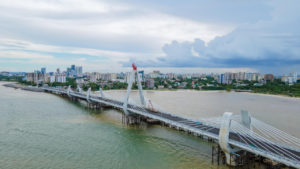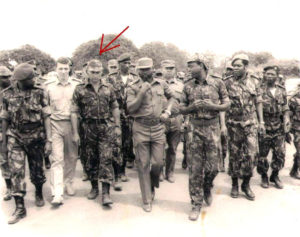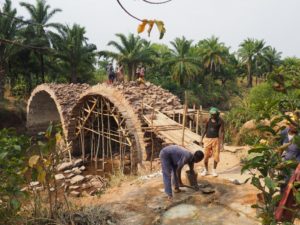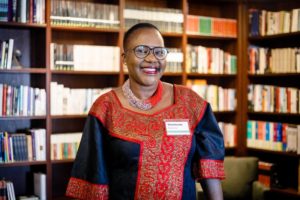by Martin Walsh
DOCUMENTING DEATH: MATERNAL MORTALITY AND THE ETHICS OF CARE IN TANZANIA. Adrienne E. Strong. University of California Press, Oakland, California, 2020. xx + 247 pp. ISBN 978-0-520-31070-4 (paperback). £27.00. eBook free to download in different formats at https://www.luminosoa.org/site/books/m/10.1525/luminos.93/
FACTORS INFLUENCING CHILD SURVIVAL IN TANZANIA: COMPARATIVE ANALYSIS OF DIVERSE DEPRIVED RURAL VILLAGES. Kumiko Sakamoto. Springer Nature Singapore, Singapore, 2020. xiii + 201 pp. ISBN 978-981-13-7638-2 (hardback). £89.99. ISBN 978-981-13-7639-9 (eBook). £71.50.
The first of these books starts with an engaging story about Paulina, the ideal, healthy, well-prepared mother-to-be. At this point, I remembered the title of the book and began to feel a sense of foreboding for Paulina, who of course did not survive the birth of her child. Her experience, and that of several others, forms a thread which runs through the book, and is referred to on several more occasions when highlighting reasons why mothers (and babies) might die in childbirth.
It all vividly brings to mind Hilda, the woman who helped in my house when I lived in Tanzania. She was a practical, intelligent woman, efficient and lovely with my kids, and she already had two of her own children. When she became pregnant, we made sure she went to all her appointments and ate good food, and we looked forward to meeting the new baby. Imagine our shock when we received the news that she had died in childbirth, along with her child. No-one seemed to be able to answer our questions about what had happened, but Documenting Death certainly sheds much light on the complexity of issues which may have contributed to her death.
Documenting Death is a fascinating and often horrifying account of the maternity ward in Mawingu Regional Hospital in Rukwa Region, a remote rural area in the far south-west of Tanzania, famed for its association with witchcraft. Adrienne E. Strong is an anthropologist from the University of Florida who spent twenty months studying the practices and dynamics of the maternity ward, in the process building strong relationships with the main players in the health sector and, due to chronic understaffing, also working on the ward, even delivering babies in the end (“But I don’t know how to deliver a baby!”, she protests. “Well, I’m going to teach you and then you will know!”, replies the nurse firmly.)
The book begins with an overview of maternal mortality and laments the lack of progress in reducing the death rate after numerous interventions. Strong points out that maternal death is a particularly sensitive indicator – most women are not ill when they come to the hospital – which clearly reveals deficiencies in the health system. She describes the hospital, the staff and the way it functions. This leads on to a detailed examination of scarcity – money, medicines and other supplies, and staff, especially nurses, – the impossible demands made on too few nurses with too few supplies which leads to low morale and motivation. She worked with the nurses for a year before starting to interview them, so that they were already familiar with her and this led to rich and frank discussions later. A whole chapter is devoted to stillbirths, a much more common occurrence than maternal mortality, but occurring as a result of many of the same factors.
There is a deep analysis of the documentation, often imposed on maternity wards from the government or the WHO. In theory, the form (partograph) to be filled in for the women should document the entire journey of each woman through the hospital, ensuring that every nurse instantly understands the progress of the birth, particularly at handover times between shifts, and any special medical issues. However, myriad deviations may occur – the nurse is in a hurry and doesn’t fill in the form, or vital information is missing, the form is misplaced, the right person does not receive the form, the form is altered perhaps in order to cover a mistake, the form disappears without trace, all meaning that the power of this simple tool is repeatedly undermined. There are many complex reasons examined as to why any of these situations may happen, but the end result can often be tragedy.
Poor communication is another factor which repeatedly comes up – for example, audit meetings were held to discuss any problems, particularly deaths, but they were infrequent, the details had often already been forgotten, the documents were unavailable, and so conclusions were often not drawn. In addition, the nurses, at the forefront of the action were not invited to the audit meetings and therefore were neither given the opportunity to contribute their ideas, nor provided with feedback which might improve their work, and by being excluded, they were denied both a voice and the personal affirmation that their opinions, knowledge and experience were of any value, leading in turn to low morale.
Later in the book, Strong steps out of the hospital into the surrounding villages – the chapter is entitled ‘Pregnancy is Poison’ – and tracks the road to maternal death, following the example of another woman, Pieta, and laying bare the complexities of local logic where reproduction is concerned. A range of social and practical issues is described, including women’s experiences of local dispensary service, bridewealth, marriage and decision making, the lack of transport and the dismal quality of village roads.
On the surface, it might appear that nurses are largely to blame for poor health care in Tanzanian hospitals, but this book provides a deep and detailed analysis of the multitude of complex reasons – social, educational, financial, professional, cultural – why things turn out as they do, and the blame must be apportioned to many. “Mawingu itself was a flawed institution, struggling with competing demands and the proliferation of government-imposed bureaucratic guidelines, but it found itself in a much more broadly dysfunctional system, the country’s health care sector as a whole” (p.192), explains Strong. At best, she comments, the care is “good enough to keep most women alive”.
At the end of the book, Strong cries out with grief and frustration for the injustice of those maternal deaths and for the overworked staff: “Sending ever-increasing numbers of women to facilities will do nothing to reduce the numbers of women dying when those facilities are poorly stocked, suffer from supply chain problems originating at the national level, have inadequate funding mechanisms due to the unequal effects of decentralization, and systematically perpetrate violence against the staff members by keeping them living in poverty, subject to abuse by superiors, denigrated on the basis of their gender, and shut out from crucial information because of poor communication, lack of transparency, and lack of respect. After all, without the supplies and skills, a hospital is just a guesthouse—full of beds and nothing else; as an environment for giving birth, it is, essentially, no better than home” (p. 202). This book is an eye-opener for anyone interested in the most basic of human experiences, childbirth, and I would certainly recommend it to anyone who wonders why development assistance often stalls, or does not produce the desired results. It is open source, freely available on the internet.
Strong’s book about maternal mortality contrasts in style with the second book, Factors Influencing Child Survival in Tanzania. Kumiko Sakamoto explains that there is much information about direct causes of child mortality, but she is interested in examining more indirect causes, for example, stemming from social structures and mutual assistance. She took a questionnaire to three different and contrasting villages in Tanzania, in Dodoma and Lindi regions and on Zanzibar, all considered to be areas with high child mortality rates. She presents an analysis of factors influencing child mortality in general and in terms of the different regions, and then turns to the individual villages. The statistical work is documented in detail, and cross-tabulation, correlation analysis, and logistic regression models are used to understand the influencing factors in child survival.
Unfortunately, the findings are not conclusive, and the author struggles to draw meaningful results from the study. Quantitative research is only as good as its questionnaire, and Sakamoto admits there were some deficiencies, for example, several Swahili words were misunderstood, therefore not eliciting the response she was hoping for, and she felt that one of the interviewers may have been biased, producing unreliable results. The questionnaire also didn’t take into account regional differences – it was one size fits all, and the research suffered as a result, for example, I was surprised that under the questions about nutrition, there were none about fish in coastal Lindi nor milk in the pastoralist village. However, the volume includes useful summaries of previous research into child survival and an overview of factors influencing child mortality in Tanzania.
Kate Forrester
Kate Forrester lived in Tanzania for 15 years, working as a freelance consultant chiefly in social development. She carried out research assignments throughout the country, several focusing on the health sector. She now lives in Dorchester, where she is active in community and environmental work.
PORINI – IN THE WILDERNESS. Bill Harvey (edited by Rolf D. Baldus). Privately published in a limited edition signed by the editor, 2022. 270 pp., 53 photos and paintings, 6 maps (hardback). Available from rolfbaldus’@’t-online.de. £30.00 + £7.00 postage to the UK.
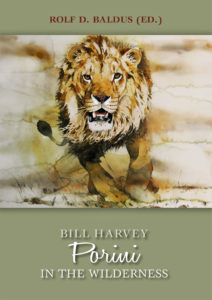
My former colleague Rolf Baldus has edited and self-published this book, which was written by Bill Harvey, the first warden of the Selous Game Reserve. Porini means ‘in the bush’, and the wild place of the book’s title is the Selous, the oldest and until recently largest protected area in Africa.
In 2005, while he was working for the Tanzanian Wildlife Division, Rolf Baldus was contacted by Bill Harvey’s son in Australia. Perry Harvey gave him a manuscript that had been written by his late father, who had worked in southern Tanganyika and the Selous in the 1920s and ’30s. Bill had written down his memories of that time while later being held captive as a Japanese prisoner of war. Perry had edited his father’s notes and records with the help of his wife and daughters, but unfortunately the family had not been successful in getting the manuscript published as a book. Instead, they had themselves produced a dozen copies.
Rolf Baldus was involved with the management of the Selous Game Reserve for many years. He has written a good number of articles about the Selous ecosystem, and edited the book Wild Heart of Africa (2009), a compilation of historical anecdotes and the natural history of the Selous, to which I also contributed. The Harvey family asked him if he could make the manuscript available to the interested public. All he could do at the time to honour their request was to upload it to his website, www.wildlife-baldus.com.
The Selous Game Reserve was established by the German colonial administration in 1896, making it the first modern protected area in Africa that still exists today. The British colonial government retained it after the First World War and gazetted it officially in 1928. They called it ‘Selous’ in memory of the great hunter and naturalist Frederick Courteney Selous (1851-1917) who was killed in combat at Beho Beho in January 1917. Bill Harvey was the first warden of the Selous Game Reserve and surrounding ecosystem from 1928 until he handed it over to Constantine Ionides in 1938, who was succeeded in turn by Brian Nicholson in 1954. Ionides narrated his life’s adventures in A Hunter’s Story (1965) and Nicholson did the same in his book The Last of Old Africa (2001).
Harvey’s book is not only an important document on the history of Africa’s oldest game reserve, but it is also very entertaining. It is full of adventure and deserves to be preserved in printed form, to keep alive the memory of this naturalist, who describes an otherwise forgotten period in the early history of the reserve.
Baldus has edited the text where necessary but thought it important to retain Harvey’s style and the spirit in which it was written. Harvey worked in colonial times, and this is reflected, for example, in his use of the word ‘native’ in a way which would now be considered politically incorrect. However, it has been left in the text to preserve its authenticity.
Harvey tells us hair-raising stories about his adventures in problem animal control, especially with elephants. He also writes also about the management challenges he and his colleagues were facing. During the Depression in 1931, “staff had been reduced to a mere skeleton”, and he had to devise means to manage the huge area under his charge with meagre resources. Like all wardens he complains about senseless office work and bureaucracy. Only when porini, on anti-poaching and animal control safaris does he find himself truly of use. He names ‘cultivation protection’ as the most difficult part of his job: elephants and hippos being the main problem. In addition, carnivores like crocodiles and lions preyed on the local population. His stories also include tales of witchcraft and the role it played in hunting down maneaters.
Since Harvey’s days, the Selous has undergone many changes, both positive and negative. Ionides and Nicholson expanded it and turned it into one of Africa’s elephant havens and a jewel of conservation. But during the 1970s and most of the 1980s it was run down by bad management and corruption.
Under the German co-funded Selous Conservation Programme, we were able to stop the elephant massacre, secure the cooperation and participation of communities around the Selous, and get the reserve going again with sustainable finance from controlled hunting and tourism under full Tanzanian management. Our colleagues Gerald Bigurube and Benson Kibonde should be mentioned here as worthy successors of Harvey, Ionides and Nicholson. If one takes the number of elephants as a measurable indicator, these pachyderms recovered during our working years from around 30,000 in the mid-1980s to well over 70,000 when Baldus left at the end of 2005.
Unfortunately, at that time the self-financing system of the reserve was done away with by the wildlife authorities and poaching was once again facilitated. In the years that followed elephant numbers dropped to 13,000 by 2013.
In 2014 UNESCO’s World Heritage Commission listed the Selous as a “World Heritage Site in danger” due to excessive poaching and planned large-scale projects such as mining and dam construction. Despite this, the government of the late President Magufuli commissioned a large hydroelectric dam at Stiegler’s Gorge in the heart of the Selous. Experts fear that this will turn out to be another ‘white elephant’, and that the heart of the Selous along the Rufiji River, with its lakes, wetlands and once abundant wildlife is being destroyed forever. A move by the World Heritage Committee to strike the Selous from the World Heritage Site List was defeated, because Tanzania was able to convince enough like-minded countries to vote against it. This happened despite clear violations of the World Heritage Site principles that the country has committed to, thus setting a bad precedent for the future.
Other infrastructural projects and surveys for minerals are ongoing, and it is apparent that the economic exploitation and fragmentation of the Selous is being officially sanctioned, with little respect for wildlife. Moreover, the Selous has been split into a reserve and a national park – an action that was taken without proper planning or following the usual legal procedures. Most of the new Nyerere National Park is unsuitable for photographic tourism, and it will likely become an additional financial burden for the Tanzania National Parks Authority (TANAPA), while depriving the Tanzania Wildlife Authority (TAWA) of essential income from sustainable hunting tourism.
Bill Harvey’s account of the early days is a good match for all those great publications in which game wardens of the past tell their exciting stories, such as Miles Turner on his Serengeti years, Bruce Kinloch on his time in Uganda, Kenya and Tanganyika, Michael Bromwich about the National Parks and wildlife management in Rhodesia and Zimbabwe, Iain Ross on Uganda’s Kidepo, and – perhaps the most entertaining of them all – Ian Parker and Stan Bleazard’s An Impossible Dream (2001), about Kenya’s last colonial wardens.
These books open up windows onto a bygone era and the lives of the custodians of game who not only achieved much for conservation under the most difficult conditions, but also enjoyed the freedom of the bush and the joy of nearly unlimited hunting as part of their job description. As Ian Parker wrote, “Our Game Department days were great fun, we led lives that, with good reason, were widely envied and, for a while at least, we were indeed the Heaven-born”.
Ludwig Siege
Dr Ludwig Siege is an economist who joined the German Agency for Technical Cooperation (GTZ) in 1980 and worked there in various capacities until his retirement in 2016. His first assignment in Tanzania was in 1983-85. After working in Zambia and Eschborn in Germany, he returned to Tanzania at the end of 1993 to take over the Selous support programme from Rolf Baldus. He left when the programme came to its end in December 2003, and subsequently worked as head of conservation programmes in Madagascar and Ethiopia.
Also noticed:
I REMEMBER AFRICA: A FIELD BIOLOGIST’S HALF-CENTURY PERSPECTIVE. Thomas Struhsaker. BookBaby, Pennsauken, New Jersey, 2021. 604 pp., 110 photos (paperback). ISBN 9781667805955. US$32.99.
Readers familiar with research on Tanzania’s wildlife are most likely to have come across Tom Struhsaker’s work on different species of red colobus, especially the Udzungwa red colobus (Piliocolobus gordonorum) and the Zanzibar red colobus (Piliocolobus kirkii). Now he’s written a full-length account of his half century in Africa. Here’s the publisher’s overview (from https://store.bookbaby.com/book/i-remember-africa-a-field-biologists-half-century-perspective, with thanks to Guy Norton):
“I Remember Africa is a memoir based on the author’s wildlife research and conservation efforts in Africa spanning 56 years (1962-2018). It describes some of the challenges scientists and conservationists faced in the early days of field research on primates and other wildlife in Africa. The stories range from the savannas of East Africa to the rain forests of Central and West Africa. The Kibale Forest in Uganda was the author’s home for 18 years (1970-1988) during the reign of vicious dictatorships, genocides, civil wars, and economic collapse. The author describes how he, his colleagues, and students managed to continue with their research and conservation efforts in Uganda, despite these adversities. Their efforts, along with many others, eventually led to the creation of The Makerere University Biological Field Station and The Kibale National Park. The stories relate humorous and uplifting experiences, set in the context of very dark times. The author also describes the behavior of the primates and other creatures he shared the forest with. This memoir tracks some of the many changes that have transpired in Africa over the past half-century.”
Martin Walsh

